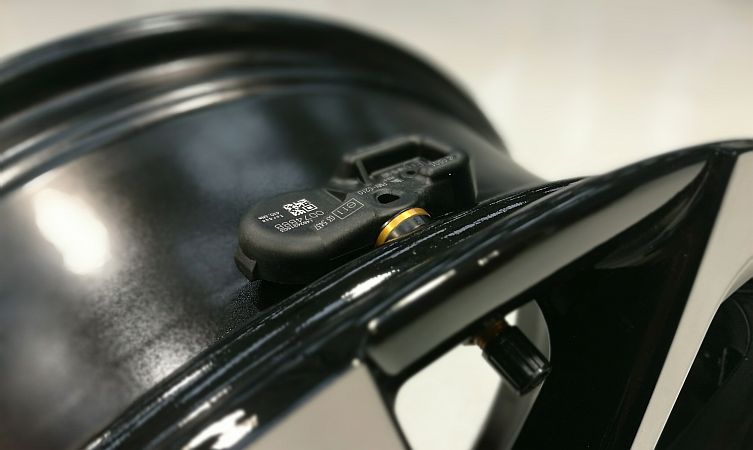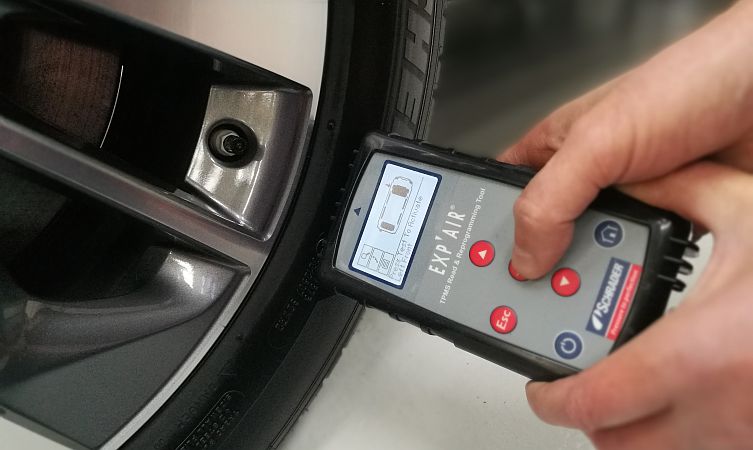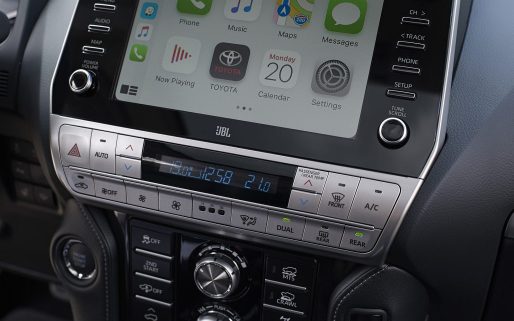Has a tyre pressure warning light appeared on your dashboard? The yellow symbol looks like the cross-section of a tyre with an exclamation mark inside. But what does the warning light mean, and what should you do about it?

What is the tyre pressure warning light?
The warning light is an alert message to the driver that there may be a loss of air pressure from one or more of the vehicle’s tyres. It comes from the Tyre Pressure Monitoring System (TPMS), an active safety technology that has become a legal requirement for all newly launched and factory updated passenger cars sold in Europe since November 2014.
Tyres represent the only contact your vehicle has with the ground, so maintaining the correct tyre pressure has many safety and efficiency benefits. These include:
- Prevents accidents caused by a critical decrease in tyre pressure
- Helps the vehicle perform predictably
- Saves fuel
- Reduces emissions
- Optimises tyre wear
How does a Tyre Pressure Monitoring System work?
There are two types of TPMS: direct and indirect. Direct systems are installed in the majority of Toyota’s current passenger car line-up, and this method uses a battery-powered sensor integrated into the valve assembly (see images below) to physically measure air pressure from within the tyre cavity itself.

Data from the sensor in each wheel is transmitted wirelessly to a control module connected to the car’s central computer, which prompts a visible alert for the driver if any of the tyres lose pressure. The control module is programmed with the unique serial numbers of the valves within the car’s system. This ensures that the TPMS assembly in each wheel only communicates with its host control module.

The only exception within Toyota’s passenger car line-up is the Proace Verso MPV. This model is equipped with an indirect system, which uses the existing wheel speed sensors within the anti-lock braking system to ‘measure’ tyre pressure by detecting differences in the rate of wheel rotation. A tyre with less air pressure will have a smaller circumference and therefore spin at a faster rate than a wheel that has not lost air pressure.
Data from the wheel speed sensors is communicated directly to the ABS control unit, which prompts a visible alert for the driver if any wheel speed abnormalities are detected.
What should I do if the tyre pressure warning light comes on?
If the tyre pressure warning light comes on, the air pressure in at least one of your tyres will have dropped below a minimum tolerance level – often a deflation of around 20-25%. This may indicate a leak, puncture, or some other kind of damage.
Dramatic changes in ambient temperature, such as driving from a snow-capped mountain to a warm and sheltered valley, can occasionally cause direct systems to prompt an alert until the temperature has stabilised. Similarly, indirect systems can occasionally mistake uneven tyre wear for a fluctuation in tyre pressure.
Irrespective of the circumstances, if the TPMS warning light comes on you should pull into a safe area and visually check the tyres. If any appear to be deflated yet undamaged you should try to re-inflate them to the correct pressure and reset the TPMS (see subheading below).
If the tyre has sustained more serious damage, it will be necessary to either continue your journey on the spare wheel, carry out a temporary repair using a tyre repair kit, or call an emergency breakdown service for a lift to a tyre centre.

How do I turn off the tyre pressure warning light?
Use the box below to identify the type of TPMS fitted to your car (only current models are listed below). You will also need to know whether the reset function is accessed via a button or sub-menu within the main display.
Once you have accessed the right sub-menu, instructions for resetting the TPMS will be shown within the main display. For those with a physical button, you simply need to turn the ignition on, then press and hold the TPMS button. The warning light will flash a couple of times and then extinguish, at which point the system has been reset.
| MODEL | TPMS TYPE | RESET ACCESS | LOCATION |
| Aygo X | Direct | Software menu | Vehicle Settings menu on Multi-info Display |
| Yaris | Direct | Software menu | Vehicle Settings menu on Multi-info Display |
| Yaris Cross | Direct | Software menu | Vehicle Settings menu on Multi-info Display |
| Corolla | Direct | Software menu | Vehicle Settings menu on Multi-info Display |
| Toyota C-HR | Direct | Software menu | Vehicle Settings menu on Multi-info Display |
| bZ4X | Direct | Software menu | Vehicle Settings menu on Multi-info Display |
| RAV4 | Direct | Software menu | Vehicle Settings menu on Multi-info Display |
| RAV4 Plug-in | Direct | Software menu | Vehicle Settings menu on Multi-info Display |
| GR86 | Direct | Button | Lower dashboard on passenger’s side |
| GR Supra | Direct | Software menu | Vehicle Status menu on Supra Command |
| Land Cruiser | Direct | Button | Under dashboard on driver’s side |
| Highlander | Direct | Software menu | Vehicle Settings menu on Multi-info Display |
| Proace Verso | Indirect | Software menu | Driving Functions menu on Pro-Touch display |
| Mirai | Direct | Software menu | Vehicle Settings menu on Multi-info Display |
What should happen if I replace any tyres?
Direct: The condition and function of the TPMS valve and sensor assembly should be checked each time the tyres are replaced. This will involve a physical inspection and electronic diagnosis using a proprietary technology (example device in image below).

The integrated battery has a life expectancy of around ten years and cannot be replaced. Electronic diagnosis should reveal the health of the battery, which will help you decide whether to replace the entire unit at the same time as the tyre.
Although the main valve assembly is robust, parts exposed to the atmosphere can deteriorate over time. So if the battery level is adequate and the main unit is being retained, it would still be wise to have the grommets, washers, collars and cores (see image below) replaced as a matter of course.

Indirect: As this system is not directly related to the tyres, no further measures are needed, assuming the tyres are being replaced on a like-for-like basis. However, it is always wise to replace the valves when changing tyres.
Will changing the wheels affect the TPMS?
Not if your car features indirect TPMS measuring. In which case, you can switch to and from winter tyres with no additional system programming.
Due to the accuracy and complexity of direct measuring, the TPMS control module is designed to recognise and communicate with only one set of wheels at a time. So if you regularly switch to and from winter wheels it will be necessary for a qualified technician to reprogramme the control module through the vehicle’s OBD port.

There are occasions when it may be necessary to drive on a wheel that is not equipped with a TPMS valve, such as after a puncture when the spare wheel is fitted. Under such circumstances, the warning light will remain illuminated. The vehicle or tyre monitoring system will not be damaged but the vehicle cannot pass its annual MoT test if the warning light is on.
Do I still have to check my tyres manually?
Although TPMS is designed to deliver a safety alert in the event of a significant loss of tyre pressure, it does not replace manual inspections. Each tyre should be regularly checked to see if it is inflated to the correct air pressure and has sufficient tread depth.







How do I know which tyre has got a low pressure as when I had a previous car and whenever a tyre pressure was low the warning light used to come and my dash used to show me which tyre has been affected and also the car has a sitting to tell me the psi level of each tyre
Hi Mohamed, thanks for your comment.
We’d always recommend regularly checking your tyre pressure (The AA suggest you do this manually every two weeks). This can be done easily using a tyre pressure gauge but make sure to do it when the tyres are cold.
The tyre pressure for your Toyota will be listed in the vehicle handbook and in the driver-side door recess.
Thanks
What do you do if Light is on and all tyres are at correct Pressure.
Toyota Auris touring 2018
Hi Fraser,
We would suggest resetting the TPMS by pressing and holding the TPMS button.
Thanks
Hello dear my car tyre pressure is fine and I change my all tyres as will in Toyota garage and I have presses the TPMS bottom so money times and have been to money garages they cant find any problems with my tyres but the pressure light is on from last six months I have no idia what the problem is . If you cold help please and my car is Toyota Prius
Hi Niazi,
Thanks for contacting us.
If you have tried both checking the tyre pressure to make sure it is correct and resetting the TPMS by pressing and holding the TPMS button and this has not worked, we would recommend taking your vehicle to your nearest Toyota Centre.
They can look over your car and make any necessary recommendations, which we are unable to do over the internet.
You can find your closest dealer here: https://www.toyota.co.uk/forms-v2/forms?tab=pane-dealer.
Thanks.
Just getting used to my new C-HR.
I would wish to customise the middle display to read similar to my Nissan Qashqui . I was able to scroll trough and see what my tyre pressures actually were. It was accurate to within a psi. I had checked this against my accurate gauge and would check the pressures routinely as I was driving. It only worked as the valve rotated passed the sensor above a certain speed. Saved getting my gauge and compressor out.
It would appear that the system fitted to my C-HR just switches a light on at a set low pressure. I was able to set the Desired tyre pressure on the display for the front and back to suit my driving speed and load. The warning light came on depending upon this setting. (I think it was 5 psi below set value)
I am finding navigating through the C-HR display very cumbersome in comparison to my 4 year old Nissan. Lots of things I would wish to see that I can’t. A example being the trip mileage. I have to start the car again to read this as the default on stop displays the total odometer reading.
My dealer has offered to help. Perhaps I need an IT degree to drive this car.
Hi Allan,
Thanks for your comment, and congratulations on your new C-HR!
We’re sorry that it doesn’t seem to suit your ideal needs, and we will make sure to pass your feedback on to our wider team.
If you have any questions that we can help with, please let us know.
Thanks.
Hi,
My Toyota Prius 2016 model Tyre pressure nozzle is broken, due to which I cant put any air in the tyre,
Its Sensor is totally fine, can I buy only nozzle valve section only or it comes as a whole TPMS assembly ?
Thank you
Hi Saqib,
Thanks for your comment.
Your nearest Toyota Centre will be best placed to assist you with this.
They will be able to assess the damage and order replacement part for your Prius.
You can find them here – https://www.toyota.co.uk/forms-v2/forms?tab=pane-dealer.
Thanks.
Hi there,
I purchased a used 2014 Yaris Hybrid but it does not appear to have a TPMS system. There is nothing in the manual, no switch under drivers side and I can’t see a warning light on the dash. Is it possible my car doesn’t have it? How can I determine if my car is equipped with this or not?
Hi,
Please provide your vehicle registration.
Thanks
It’s SV14 DFP.
Thanks for looking in to this for me!
Hi Jenny,
Your vehicle does not have TPMS.
Thanks.
Thanks for letting me know.
Can you confirm why that would be as this page states:
‘Every new or revised Toyota passenger vehicle* launched in the UK market since November 2012 has been equipped with a TPMS.’
Seems odd mine wouldn’t have it considering it’s from 2014.
Thanks a lot.
Hi Jenny,
We’d recommend contacting your nearest Toyota Centre for further help and advice with this, as they will be able to inspect your vehicle.
Thanks.
I need two new tyres on the rear wheels is it possible to have the new tyres fitted to the front wheels and then fit the nearly new tyres off the front to the rear wheels so the brand new and better tyres would be on the front
Hi Mike,
Sure!
Thanks
Can this system be disabled all together on a 2014 Toyota Yaris?
Hi Brian,
Sorry, we can’t recommend modifying the vehicle away from manufacturer specification.
Thanks
Hello, I have a 2020 Toyota Corolla 1.8 hybrid. I am ordering winter tires and just want to confirm that my car does not have a direct TPMS.
If the tire pressure is low, I get the cross-section tire and exclamation mark symbol. I do not get any specific info about which tire is the culprit and what state it is in.
This would mean I have an indirect system that measures wheel speed rather than pressure.
Is that correct?
Thanks for any insight.
Hi Matthew,
Thanks for your comment.
As we are only able to advise on UK specification vehicles, we would recommend contacting Toyota in your region for further advice.
Thanks.
I have a CHR and the tyre pressure warning light has come , how can I tell which tyre is deflated ?
Hi Sean, thanks for your comment.
You can reinflate the tyres on your C-HR at your local petrol station. When you go to do this, the machine there will tell you the current pressure of each tyre and you can check this against the required amount which should be displayed just inside the door shut.
Thanks